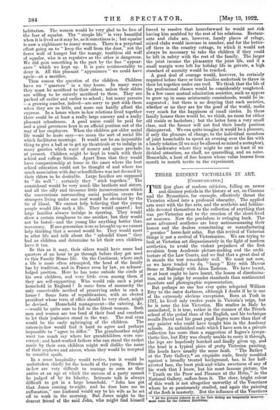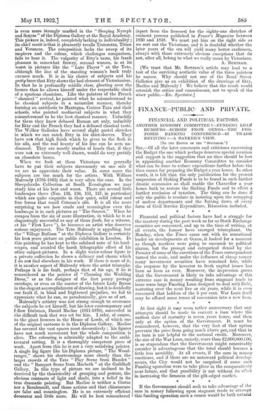THREE EMINENT VICTORIANS IN ART.
[COMMUNICATED.]
THE first glare of modern criticism, falling on newer and dimmer periods in the history of art, on Cezanne and the Byzantines, for example, effectively thrust the Victorian school into a profound obscurity. The applied arts went with the fine arts, and the aesthetic and fashion- able devoted themselves to the collection of anything that was pre-Victorian and to the creation of the short-lived art nouveau. Now the pendulum is swinging back. The more advanced aesthetes are busy antimacassaring their homes and the dealers resuscitating or manufacturing " genuine " horse-hair sofas. But this revival of Victorian things is not a revival of Victorianism. We are trying to look at Victorian art dispassionately in the light of modern aesthetics, to avoid the violent prejudices of the first revulsion from Academic picture-making and the archi- tecture of the Law Courts, and we find that a great deal of it stands the test remarkably well. We must not now, as we have tended to do, lump " Etty with Marcus Stone or Miilready with Alma Tadema. We have learnt, or at least ought to have learnt, the lesson of discrimina- tion and to judge by sounder standards than sentimental anecdote and photographic representation. But perhaps no one has ever quite relegated William Etty to the outer darkness, although I doubt if he is one of the extremely obvious exceptions. Born at York in 1787, he lived only twelve years in Victoria's reign, but he is none the less Victorian. His studies in Italy he assimilated, it is true, rather in the manner of the French school of the period than of the English, and his technique recalls David and his great pupil Ingres more than that of any painter who could have taught him in the Academy schools. An unfinished nude which I have seen in a private collection has more than a suggestion of Ingres's sympa- thetic line, but Etty was clearly unable to carry it through, the legs are hopelessly botched and finally given up, and the head is a typical piece of pretty Victorian painting. His heads have usually the same fault. " The Bather ' at the Tate Gallery,* an exquisite nude, firmly moulded against a broadly treated background, has, in her half- averted face, the least pink-and-white sweetness of any of his work that I know, but his most famous picture, the " Youth on the Prow and Pleasure at the Helm," in the National Gallery, suffers from it. The clear, bright colour of this work is not altogether unworthy of the Venetians whom he so passionately studied, and again the painting of the flesh is masterly. But the influence of the Venetians
• All the pictures referred to at the Tate Gallery are temporguily removed: make room for the Cotman Exhibition,
is even more 'strongly marked in the " Sleeping Nymph and Satyrs " of the Diploma Gallery at the Royal Academy. This picture is, indeed, completely lacking in individuality ; its chief merit is that it pleasantly recalls Tintoretto, Titian and Veronese. The composition lacks the sweep of its inspirers and the colour, which challenges comparison, fails to bear it. The vulgarity of Etty's taste, his frank pleasure in somewhat frowzy, sensual women, is at its worst in pictures like the " Lute Player " at the Tate, although the line of the standing woman's back truly excuses much. It is in his choice of subjects and his pretty faces that Etty shows the bad element of Victorianism. In that he is profoundly middle class, gloating over the licence that he allows himself under the respectable cloak of a spurious classicism. Like the painters of the French " classical " revival, he painted what he misunderstood to be classical subjects in a naturalist manner, thereby forming an antithesis to Mantegna, Cosimo Tura and their schools, who painted mediaeval subjects in what they misunderstood to be the best classical manner. Unluckily for them they knew debased Roman art only, unluckily for Etty and the French they had a debased classical taste. The Walker Galleries have several slight pastel sketches in ,which we can catch Etty in his shirt-sleeves. They have not that high finish which he gives to the flesh in his oils, and the real beauty of his line can be seen un- dimmed. They are mostly studies of heads that, if they were not so extremely well drawn, would do very prettily on chocolate boxes.
When we look at these Victorians we generally have to put their subjects strenuously on one side if we are to appreciate their value. In some cases the subjects are too much for the artists. With William Mulready (1786-1863) that is very often the case. Li the Sheepshanks Collection at South Kensington we may study him at his best and worst. There are several little landscapes there (Nos. 135, 136, 151, 157, in particular) which are quite exquisite in their quiet, solid colour and free forms that recall Cotman's oils. It is all the more surprising to see how crude and meaningless even the landscape is in such pictures as " The Sonnet." When he escapes from the sin of mere illustration, in which he is as disgustingly successful as any of them (look, for a witness, at his " First Love "), he becomes an artist who deserves serious enjoyment. The Tate Mulready is appalling, but the " Village Buffoon " at the Diploma Gallery is certainly his best genre picture on public exhibition in London. In • this painting he has kept to the subdued note of his land- scapes, and avoided the harsh lithographic effect of his other subject-pictures. In a slight water-colour figure in a private collection he shows a delicacy and charm 'which I do not find elsewhere in his work. If there is more of it, it is another aspect of Mulready where the artist triumphs. Perhaps it is his fault, perhaps that of his age, if he is remembered as the painter of " Choosing the Wedding Dress," or as the designer of the first penny postage envelope, or even as the master of the future Lady Byron in the elegant accomplishment of drawing, but it is decidedly our fault if, in blind and frightened prejudice, we fail to appreciate what he can, so paradoxically, give us of art.
Mulready's artistry was not strong enough to overcome the subjects he set himself, but his later contemporary and Lllow Irishman, Daniel Maclise (1811-1870), succeeded in the difficult task that was set for him. I refer, of course, to the giant frescoes in the House of Lords, of which one of the original cartoons is in the Diploma Gallery. Maclise has covered the vast spaces most decoratively ; his figures have not much movement but the whole composition is alive. The colouring is admirably adapted to the archi- tectural setting. It is a thoroughly competent piece of work. Apart from this he is not a very satisfying painter. A single big figure like his Diploma picture, " The Wood- ranger," shows his shortcomings more clearly than the larger crowds of the Tate " Play Scene from Hamlet " and the " Banquet Scene from Macbeth " at the Guildhall Gallery. In this type of picture we are inclined to be deceived by the theatricality of grouping and gesture, the obvious contrasts of light and shade, into a belief in its true dramatic painting. But Maclise is neither a Giotto nor a Rembrandt, and those actions and that chiaroscuro are false and meaningless. He is an extremely efficient decorator and little more. He will be best remembered (apart from the frescoes) for the eighty-one sketches of eminent persons published in Fraser's Magazine between 1830 and 1838. We must put him on the right side as we sort out the Victorians, and it is doubtful whether the later years of the era will yield many better craftsmen, always with those extremely obvious exceptions that do not, after all, belong to what we really mean by Victorians.
A. BERTRAM.
[We trust that Mr. Bertram's article may lead to a test of the surviving aesthetic value of the three painters he names. Why should not one of the Bond Street Galleries give us an exhibition of the drawings of Etty, Mediae and Mulready ? We believe that the result would astonish the critics and connoisseurs, not to speak of the wiser public.—ED. Spectator.]



































 Previous page
Previous page